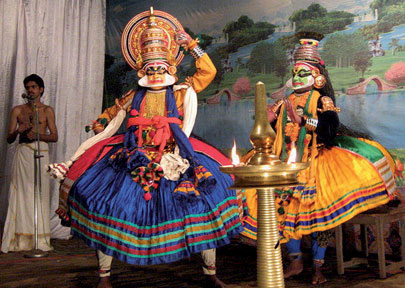 |
|
Kathakali dancer |
The role of males in the Indian classical dance forms
By Subashini Pathmanathan
The role of males in Indian classical dance forms is immeasurable. In
many Indian classical dance forms, like Kathakali, Kuchipudi, Ordissi,
and Bhagavatha Mela, were only performed by the male dancers in ancient
times. During later years, the females started participating in these
classical dance forms, except Bhagavatha Mela. Kuchipudi is a classical
dance of Telegu Desha, based on drama. Earlier, the male dancers,
dressed themselves, as female dancers, and danced, but later females
started playing important role in Kuchipudi. Today Kuchipudi is the
classical dance form of Andhra Pradesh, and female dancers are the main
participants.
The Bhagavatha Mela is another Indian classical dance form that has
close links with Kuchipudi. Like Kuchipudi, this is also a drama based
dance, that’s why it is considered as dance drama. Like in Kuchipudi
oral conversation, takes place, between the dancers and the musicians.
Bhagavatha Mela dance drama is still preserved and practised by the
males only. The special feature of Bhagavatha Mela is only preserved and
practised by the male Brahmin community. However, Bhagavatha Mela dance
drama had laid down a firm foundation for the development of dance
drama, in Bharatha Natyam.
Beside these, Odissi dance had its origin from Orissa state. Earlier
Odissi dancers were males. They were called Gothipuas. These male
dancers dressed themselves as females while they danced. It is
essentially a temple dance. Even today, many of the Odissi dance
teachers are Gothipuas of yesteryears. The male dancers Gothipuas are
still dancing. The music of Odissi is a fusion of Carnatic music and
Hindustani music. Traditionally Gothipuas were dancing on two important
occasions. One was Chandran Jatra, and the other was Jhoolan Jatra.
Initially this dance form originated and was based on Vaishnava cult.
And later it was cherished and adopted in Saivaism. In olden days, they
adorned themselves with many ornaments, but today they sparingly use
limited and necessary ornaments.
Another Indian classical dance form is Kathak. It is a popular
classical dance form of North India. Here in this classical dance form
the male dancers play equal role with female dancers. Even in teaching
Kathak, the role of the males is equally important. The male Kathak
dancers wear simple costumes. They wear long pyjama and specially
designed tops. They do not wear much ornament, and they do not have any
hairdressing.
Kathakali is another Indian classical dance form based on Hindusim.
The male dancers dance even the female characters, and still males play
major role in this classical dance form. Originally, the males alone
danced this. These male dancers were called Chakayer. The music is
totally based on Carnatic music. The dance themes are generally based on
various epics, puranic, and ithikasa stories. Kathakali dance form use
heavy makeup and use different masks appropriate to the character
portrayed. Keeredam or the crown is worn by the dancers along with the
face side masks. The ornaments are placed and tied over the dresses.
 |
|
Kathakali dance
performance |
Another Indian classical dance form is Manipuri. The male dancers
play equally important role with female dancers. The male Manipuri
dancers generally carry different variety and different shapes of drums,
while they dance. Sometimes while dancing they carry large cymbals
(which are called Kartaal). The male Manipuri dancers generally wear
white dhotis, and many of times, they do wear white colour turbans. This
is the special and distinct feature of the Manipuri male dancers as
compared to male dancers of other Indian classical dances. They hardly
wear any ornaments. Even they do not wear ankle bells.
India’s most popular classical dance form is Bharatha Natyam.
Bharatha Natyam evolved out of Sathir. In ancient days, many male
dancers danced Sathir in temples. They were called by various names,
like Chakai Marayan, Poonan, Santhi Koothan, Kootha Peraiyan, Nattuva
Aassan, and Araiyer. High awards were awarded to these outstanding male
dancers in olden days. For instance, ‘Nattuva Kulothunga Chola Nirtha
Peraiyan’, ‘Thiruvorai Chakai Mummudi Chola Nirutha Peraiyan’ were some
of the titles conferred on the outstanding performers. Still there are a
number of outstanding male dancers and numerous outstanding dance
teachers, choreographers (some belong to the traditional Nattuvanar
clan) are in the classical Bharatha Natyam field.
In all the Indian classical dance forms, the males play important
role with female dancers. The contribution of males for the development
of certain classical dance forms are more than that of the females.
Kuchupidi and Odissi originally, were danced by males alone. Bhagavatha
Mela is still wholly performed by the male performers, and in Kathakali,
the male dancers play more important role than female dancers.
In Kathak, and Manipuri the role of the male dancers are equally
important as that of female dancers.
In Bharatha Natyam the most outstanding gurus were the males, and
today there are a very few out standing male performers in this field.
|

